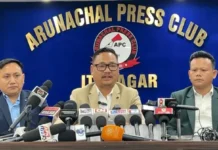[ Tongam Rina ]
ITANAGAR, Oct 27: National Green Tribunal (NGT) has directed the Ministry of Forests, Environment and Climate Change (MOEF & CC) to constitute a Committee with three expert members within one month to study NHPC’s 2000 MW Subansiri Lower Hydro Electric Project akin to Project Oversight Committee (POC) which was set up by the Ministry of Power in 2014 to examine various issues pertaining to the project and to recommend measures for its resolution. The judgment was pronounced on Oct 16.
Records say that this will be the 9th such study including one by the Technical Expert Committee of now redundant Planning Commission regarding the project which has been forced to halt construction since December 2011 following agitation by Assam based organization including All Assam Students’ Union, Asom Jatiyatabadi Yuva Chatra Parishad and Krishak Mukti Sangram Samiti demanding study on downstream impact and reduction in height of the Dam.
The Committee shall objectively consider all the aspects, both technical and factual, and arrive at an independent opinion report within three months, read the judgment.
It said that members may be selected from amongst accomplished experts and scientists who may be private individuals or from institutions of repute having undertaken studies on the seismology, geology, hydrology of rivers and river eco-system of the Himalayas and the North Eastern region of the country and that one member shall be from the region.
The POC of 2014 was mandated to review the safety aspect of the dam and downstream impact with four members from Expert Group of Assam including experts from IIT Guwahati, Dibrughar and Guwahati University and one each from Central Electric Authority , central water commission, Geological survey of India and IIT, Roorkee.
But even after 12 rounds of meetings held by POC between January 2015 to February 2016,
the Committee could not come to a conclusion due to differences of opinions leading to submission of two reports, one by the POC experts of Assam that raised series of questions on seismic, geology and spillway design.
While disposing two applications, Justice SP Wangdi and Expert Member Prof P C Mishra said that the new committee may visit the project site and its vicinity, hold meetings with both the constituents groups of POC- the expert group of Assam and the expert group nominated by the Govt. of India, NHPC and the appellants.
The Committee shall technically examine the reports of the various Committees including the ones submitted by both the groups of the POC and independent experts on hydel projects.
It directed that MoEF & CC shall then refer the report and the recommendations of the Committee for stage IV appraisal by the Expert Appraisal Committee under the EIA Notification, 2006. The Expert Appraisal Committee has been directed to complete the appraisal within sixty days and place it before the competent authority for final decision.
One of the applicants Aabhijeet Sharma had gone to the NGT seeking redressal for the rights of the riparian tribal people of the downstream of the project and regarding the ecology of the Subansiri River which is home to the Gangetic Dolphins.
The petitioner is not challenging the construction of dam per se but is confined to the downstream impact of the dam on the ecology of the river and the riparian people, the judgement read.
In its 104 paged judgment, NGT noted that even the purpose for which the POC was set up has not been achieved. Accepting recommendations selectively would certainly not end the imbroglio considering the serious questions raised on the reliability of the measures adopted in the project, it said.
Subansiri Hydel Project is of 2000 MW and is said to be the largest in the country and, concededly, it is being set up in an extremely fragile eco-sensitive zone, the judgment read adding that Committees set up to examine the questions raised on the various aspects of the project have been found to be fragmented and conflicting in their views. Endeavours should be made to reconcile the views to arrive at universally acceptable and safe way forward, the judgment read.
The main contention of the various groups from Assam opposing the project has been regarding limiting the Environmental Impact Assessment study to 10 Km downstream from the dam whereas the river flows 130 KM till it meets the Brahamaputra and 116 metre height of the dam which experts say will have severe downstream impact. The Assam government had set up the expert committee in December 2006 comprising members from IIT Guwahati, Dibrugarh and Gauhati University that had questioned the designs of the NHPC project. In its report it noted that the spillway was designed for a maximum discharge of 12,024 cumec, whereas the maximum discharge recorded was more than 21,230 cumec on July 11, 1971. The project’s initial cost estimate was Rs 6285 crore when construction began in 2005 which is now estimated at Rs 17,435 crore, according to an NHPC official.
By 2007, the diversion of the river was completed following which the excavation works were carried out. However, the dam was subject to redesign a year later.
The saga continues even as the central as well as government of Arunachal is impatient about completion of the project scheduled for 2018 but so far only 50 percent of work has been completed setting an example- why pertinent questions of safety and downstream impacts should not be undermined when undertaking the largest hydro power project in the country.



